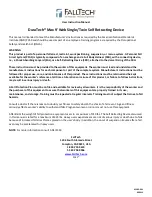
4.6 Twin-leg SRDs:
Twin-leg SRD housing ends are attached to the straps of a properly adjusted and fitted FBH with a specially-configured triple-
locking twin-SRD carabiner. Connect the leg ends to anchorages within the correct orientation range.
Refer to Figure 2C.
DO NOT
attempt to install the twin SRDs specially configured carabiner to an anchorage.
CAUTION:
Do NOT connect the leg ends of twin SRDs to two anchorages at the same time, except for the brief time when transitioning from one
anchorage to another.
4.6.1 Install the Twin-SRD:
To install the SRD housings onto the FBH, follow the procedure detailed in Figure 7A.
1. Prepare Twin-leg SRD for Attachment
2. Prepare FBH and Preliminary Attachment
3. Reinstating 2nd SRD Unit
4. Closing and Securing
WARNING
Ensure the carabiner is correctly installed on the FBH as shown in Figure 7A. Incorrect installation may result in serious injury or death.
Figure 7B shows common INCORRECT connections.
4.6.2 Twin-leg SRD Work Zone Transition:
This SRD is designed for attachment of one leg end at a time during work performance.
Dual connection
is for transitioning
from one work zone to another only, as shown in Figure 8.
Attach one leg end connector to a suitable anchor. The user may then move to another work location and attach the unused leg to another suitable
anchorage. Detach the original attached leg. Repeat the procedure, until the desired work location is reached.
4.7 Locking Speed:
The SRD utilizes a centrifugally activated pawl locking mechanism to engage a brake to slow and arrest the user in a fall event.
This requires a certain minimum pay-out rate to function. Some situations, confined or cramped spaces, shifting footing such as sand, gravel, grain,
or a sloped surface, may not allow the lifeline to reach sufficient speed to activate the lock mechanism. A clear fall path is required to assure
positive locking of the SRD.
4.8 Impact Indicator:
The primary fall event indicator is a stitched fold in the lifeline above the EA. The secondary indicator is the deployment of
the EA itself. Any torn stitching in the fold accompanied by any expansion or lengthening of the EA is an indication that a fall event has occurred. If
you have any questions contact FallTech at [email protected].
Inspect the unit before each use in accordance with the instructions in this manual. If any of the above conditions are evident, remove the SRD
from service immediately.
DO NOT
allow the lifelines to become tangled or twisted together as this may prevent them from retracting.
DO NOT
allow any lifeline to pass under arms or between legs during use.
DO NOT
clamp, knot, or prevent the lifeline from retracting or being taut.
DO NOT
lengthen the SRD by connecting a lifeline or similar component.
DO NOT
allow the lifeline to freewheel back into the housing.
After a Fall:
Remove from service immediately any equipment subjected to fall arrest forces, or exhibiting damage consistent with the effects of fall
arrest forces.
5. SPECIFICATIONS
See Table 1A – E
6. MAINTENANCE, SERVICE AND STORAGE
6.1 Maintenance:
Keep the SRD free of contaminants such as paint, grease, grit and chemicals as this may hinder lifeline functions. Keep debris
from entering the housing through the lifeline port. Clean the exterior of the unit as required with a soap/water solution. Do not allow any water
inside the housing. After cleaning, pull the lifeline all the way out, allow the unit to air dry, then retract the lifeline into the unit. Do not allow the
lifeline to freewheel into the housing. Maintain tension.
DO NOT
use heat to dry.
DO NOT
attempt to disassemble the SRD.
Inspect the SRD according to the procedures in Section 7 before returning it to service. If the SRD fails any portion of the inspection checklist,
remove it from service, tag the unit as “UNUSABLE”, and consult with the manufacturer.
6.2 Service:
Remove the unit from service if it has been subjected to fall arrest forces. Tag the unit as “UNUSABLE” to prevent future use. The SRD
is not repairable.
6.3 Storage:
Hang to store, out of direct sunlight. Ensure the lifeline is completely retracted into the housing. Avoid exposure to chemical agents
and vapors, airborne debris, and water ingress.
Store units tagged as “UNUSABLE” in a clearly marked area to prevent inadvertent use. Inspect any unit that has been stored for an extended time
in accordance with the procedures detailed in Section 7.
7. INSPECTION
7.1 Pre-Use Inspection:
Perform an inspection before each use in accordance with Table 3: Guidelines for Web SRD Inspection. See paragraph 7.4.
7.2 Inspection Frequency:
OSHA 1910.66, OSHA 1926.502 and ANSI Z359.14 require an inspection by the Authorized Person before each use. In
addition, an inspection by a Competent Person at regular intervals is required. The Competent Person will use the information in Table 2: ANSI
Z359.14 SRD Inspection Requirements, to determine the inspection frequency.
7.3 Inspection Checklist:
Use the Inspection Checklist provided in Table 3: Guidelines for Web SRD Inspection to inspect the SRD.
7.4 Inspection Results:
If an inspection reveals defects in or damage to the equipment, inadequate maintenance or activated fall force indicators,
mark as “UNUSABLE” and remove the equipment from service.
7.5 Inspection Document:
Record inspection results on the Inspection Record provided in Appendix B, or on a similar document.
6
Summary of Contents for DuraTech Max Web Single
Page 7: ...8 LABELS The labels must be present and legible 7...
Page 15: ...15...







































